The guitar bridge is more important than you might first think. It’s play a major role in how a guitar sounds, it’s tuning, intonation, sustain and general playability.
But with so many different types of guitar bridges available it can be difficult to know what they do and which is right for you. From classic fixed bridges to modern tremolo systems each type of bridge offers its own unique benefits and drawbacks, all of which will affect how your guitar plays and feels.
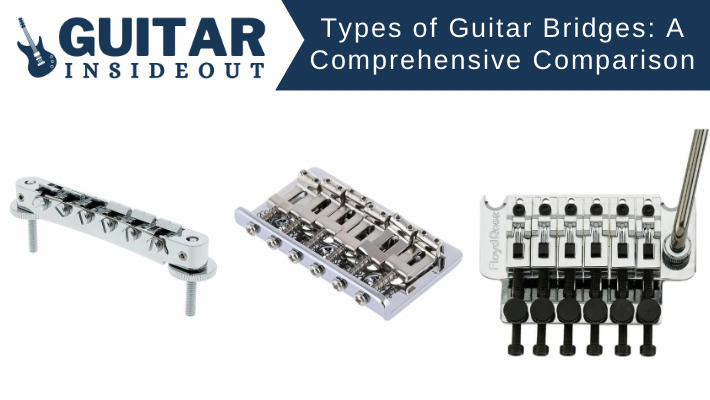
So if you’re interested in learning more about guitar bridges this guide is for you. I will go through the most common types of bridges, their features, advantages and disadvantages and more.
Whether you’re a beginner who wants to learn more or experienced and looking to upgrade your guitar you will find all you need here to get the right bridge.
Categories of Guitar Bridges
There are quite a few types of electric guitar bridges. But they mostly fall under two main categories: fixed bridges and floating bridges (also known as tremolo bridges).
Within each of these categories you have multiple different types, each with their own characteristics.
Fixed Bridge
Fixed bridges, commonly known as hardtail bridges, are probably the most basic type of guitar bridge. They’re found on both electric and acoustic guitars of many different brands and models.
As the name suggests, fixed bridges are fixed in place. This means they are non-adjustable and are designed to keep the strings anchored to the guitar’s body at a fixed point.
A fixed bridge typically is made up of a metal plate or block and saddles that hold the guitar strings in place. The saddles are adjustable to allow you to change the intonation.
Because a fixed bridge doesn’t allow for pitch changes or vibrato effects it is often preferred by guitarists who play genres like blues, jazz and rock that don’t need them. It also tends to provide better sustain and stability than floating bridges as there are no springs or moving parts.
Fixed bridges are your sort of no frills, get the job done type of bridge. If you want reliability, simplicity and knowing your bridge is unlikely to cause you any issues then they’re ideal.
They may not offer all the bells and whistles of some other bridges but they’re extremely popular for a reason.
Floating Bridge
A floating guitar bridge, also known as a floating tremolo or floating vibrato bridge, differs from a fixed bridge by allowing you to manipulate the pitch of the strings by moving the bridge up or down. This creates a vibrato or tremolo effect.
The floating bridge is mounted to the guitar’s body with two pivoting points and is designed to “float” above the guitar’s surface, hence the name. The strings are attached to the bridge at one end and the tuning machines at the other end and held in place by saddles that can adjust the string height and intonation.
While floating bridges give you the opportunity to create these additional sounds and effects it comes at a price. Floating bridges have a tendency to go out of tune frequently, especially when the tremolo bar is used a lot.
Their complex design can also make setting them up much harder work than other types of bridges.
Types of Electric Guitar Bridges
Hardtail Bridge
A hardtail is the most simple and straightforward type of bridge. It is mounted directly to the guitar’s body with a metal plate or bar and has several adjustable saddles that hold the guitar strings in place. Unlike floating bridges there is no cavity or space under the bridge for the strings to move which increases sustain.
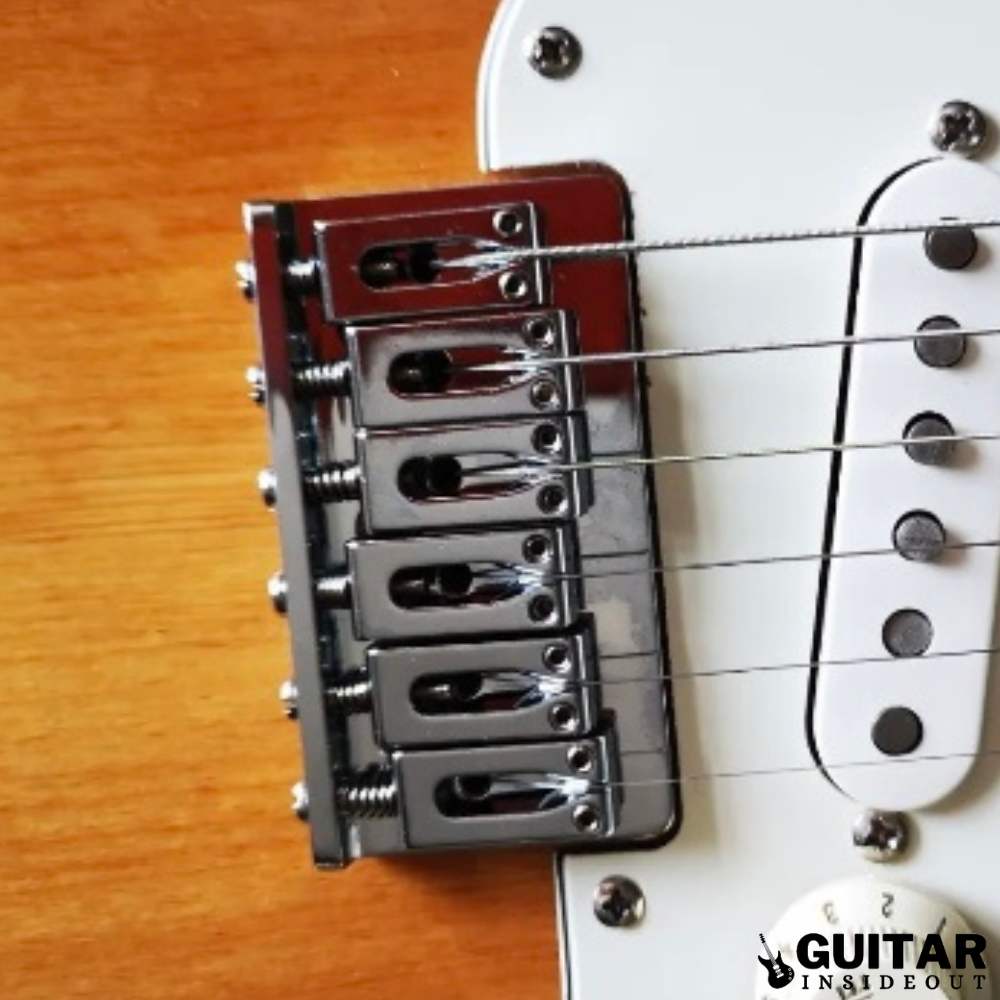
The saddles on a hardtail bridge can be individually adjusted for string action and intonation. This lets you make very precise adjustments to the guitar’s setup.
They are popular because of their simplicity and the fact they are so easy of use. The design is straightforward and requires minimal adjustment and the lack of a tremolo system also means that the guitar is less likely to go out of tune during aggressive playing or when using heavy gauge strings.
Advantages of Hardtail Bridges
- Excellent tuning stability due to the fixed position of the strings.
- Better sustain compared to other types of bridges.
- Simple design and construction make them easy to maintain and repair.
Disadvantages of Fixed Bridges
- Limited adjustability makes it difficult to adjust intonation, string action and action at the bridge.
- Bending strings and vibrato techniques are limited due to the fixed bridge design.
- You may find a fixed bridge less comfortable to play compared to other bridge types.
Examples of Hardtail Bridges
A Fender Stratocaster that comes with a hardtail bridge is probably the most obvious example of hardtail.

While the traditional Stratocaster has a tremolo bridge the hardtail version has become extremely popular.
Most acoustic guitars come with a hardtail bridge with pins as well.
Floyd Rose Bridge
Floyd Rose bridges (known as locking tremolo systems) are a type of locking tremolo bridge. Due to their design they provide great tuning stability and allow for extreme vibrato techniques and tricks like dive bombs without losing tuning. This is achieved through a unique locking nut system and fine tuners on the bridge itself.
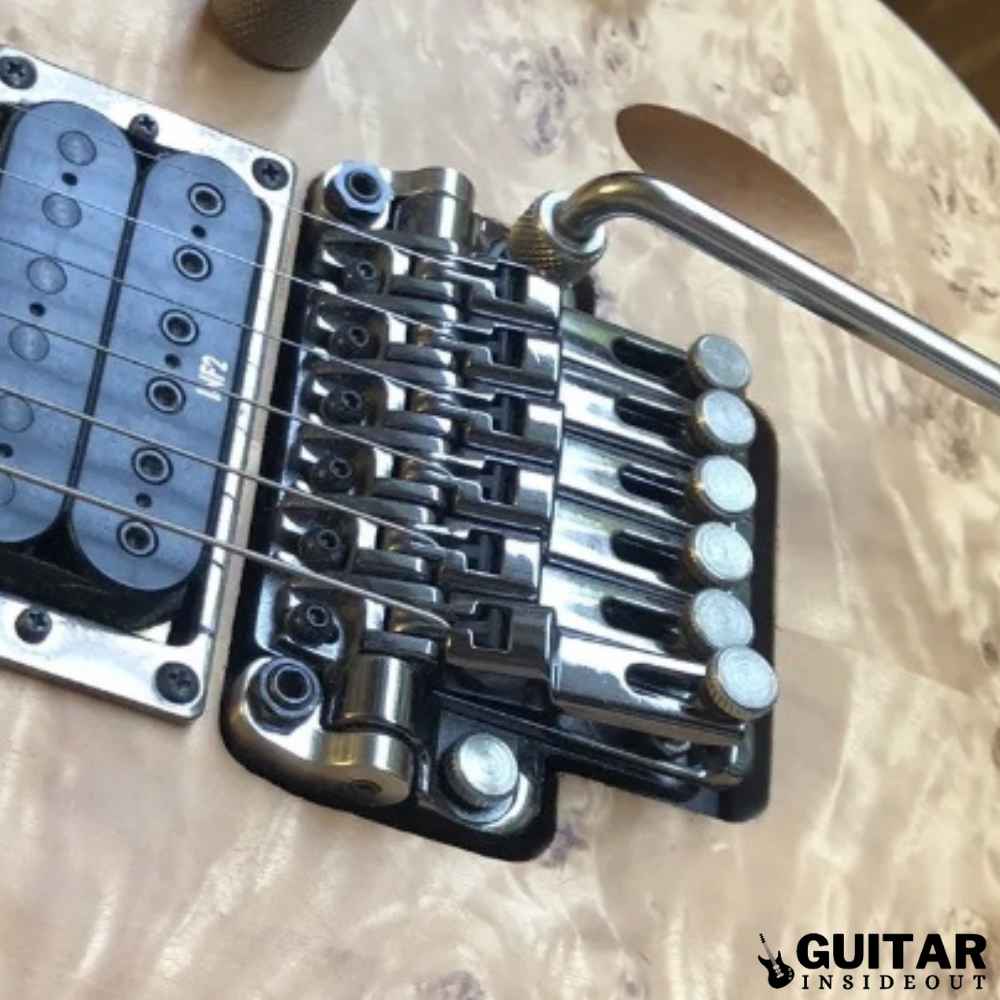
A Floyd Rose bridge consists of a metal base plate which is mounted to the guitar’s body with six saddles that hold the strings in place. A set of springs helps to balance the tension of the strings and keeps the guitar in tune.
At the other end a Floyd Rose system features a locking nut which clamps down on the strings and prevents them from slipping out of tune when the tremolo arm is used a lot. This is one of the major factors that sets it apart from other bridge types which don’t have any special type of nut.
One of the main advantages of the Floyd Rose bridge and why guitarists choose it is it keeps the guitar in tune even when the tremolo arm is used heavily. The special locking nut prevents string from slipping and the spring system lets the strings withstand big pitch changes.
Floyd Roses are, however, much more difficult to setup. Changing strings is a lot more challenging too and they aren’t a good choice for a lot of types of music. It’s why they’re not usually recommended for beginners.
Advantages of Floyd Rose Bridges
- Exceptional tuning stability, even with extreme vibrato techniques.
- Locking nut system helps prevent string slippage and improves tuning stability.
- Fine tuners on the bridge allow for precise tuning adjustments.
- Can be used for various playing styles, allowing you to go from subtle vibrato to extreme dive bombs.
Disadvantages of Floyd Rose Bridges
- Much more difficult to set up and maintain compared to other bridge types.
- Changing strings is more time-consuming and awkward due to the locking nut system. Takes a while to get used to it.
- Can be expensive compared to other types of bridges.
Examples of Floyd Rose Bridges
You find Floyd Roses on guitars that are suited to or associated with metal or shredding. So lots of Ibanez’s and Jackson’s have Floyd Roses.

If you want the ability to really use the tremolo arm hard or need total stability when it comes to tuning then a Floyd Rose will probably fit the bill. But be warned – they take some time to get used to and are undoubtedly more awkward to maintain and setup.
Tremolo Bridge
Tremolo bridges, or vibrato bridges as they’re also known as, are some of the most popular bridges and are famous for the ‘whammy bar’ or ‘tremolo arm’. Together this bridge and metal bar allow players to vary the pitch by pushing on the bar which moves the bridge up and down.
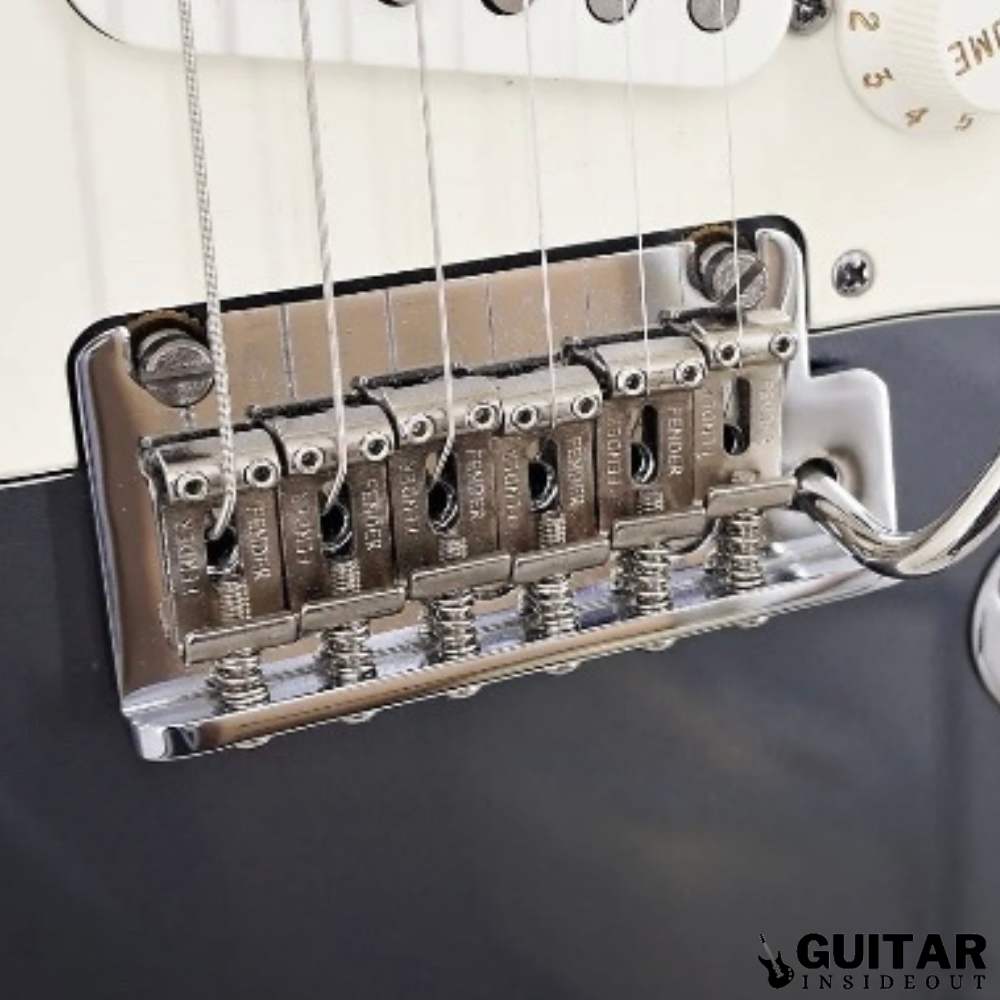
The tremolo bridge consists of a metal plate or block that is anchored to the guitar’s body. The strings are threaded through the bridge and anchored at the back of the guitar which provides a secure connection between the strings and the body.
The tremolo arm, also known as a whammy bar, is attached to the bridge and allows you to create vibrato effects by changing the pitch of the strings. It’s a lot of fun!
Unfortunately tremolo bridges do have a tendency to go out of tune more easily than other types of guitar bridges, especially when the tremolo arm is used. There’s also the fact that using heavier gauge strings can make the strings more likely to break on tremolo bridges.
And much like the Floyd Rose it can be a major pain to setup properly.
Advantages of Tremolo Bridges
- Much greater versatility and flexibility compared to fixed bridges.
- Greater potential for more interesting and varied sounds through vibrato techniques.
- Some tremolo systems allow for quick and easy string changes.
Disadvantages of Tremolo Bridges
- Tuning stability is frequently poor because of the moving bridge design.
- Can be more complex and difficult to maintain and repair compared to fixed bridges.
- When compared to fixed bridges sustain and resonance is reduced.
Examples of Tremolo Bridges
A Fender Stratocaster is the guitar most synonymous with the tremolo bridge. Many Strats still have the iconic whammy bar but it’s also a big feature in other guitars. A whole lot of Squier models, the Schecter Omen Extreme and PRS Custom 24 all have a tremolo.

If above all else you want a stable and simple bridge then the tremolo is probably best avoided. It might be a good choice for those who enjoy experimenting with pitch bending and vibrato effects. But you have to take into account the loss of tuning stability and the extra effort and hassle that is included in setting up a tremolo bridge.
Wraparound Bridge
Wraparound bridges are a type of fixed bridge that are commonly found on Gibson-style guitars. As the name suggests the strings wrap around the bridge. This design is simple – the strings just go over the bridge, down and under it – and makes them easy to use and maintain (see the image below).
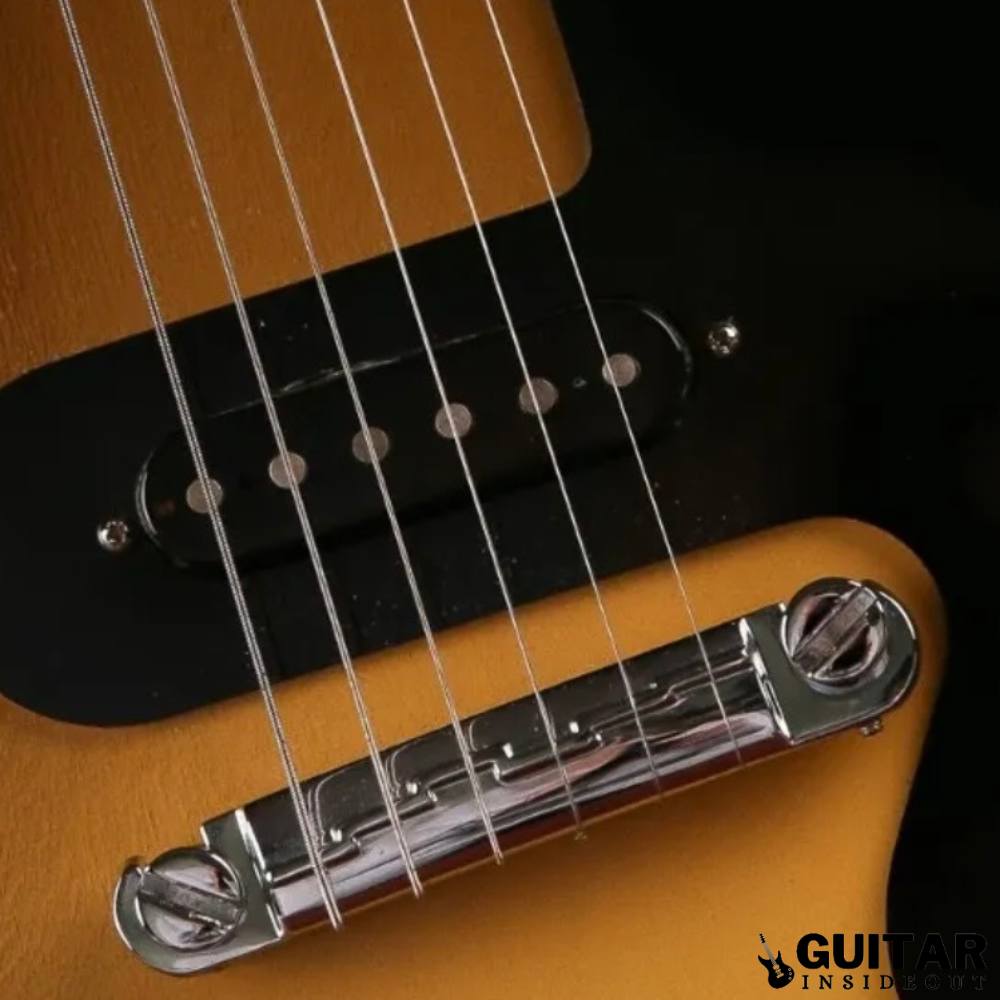
One difference to other types of bridges is that wraparounds don’t have individual saddle to adjust each string. This means you have to move the entire bridge forward or backward to adjust the intonation.
Whilst that does make them a lot simpler it also means you end up with limited options to adjust the bridge. As the intonation is adjusted by moving the entire bridge rather than individual saddles you may struggle to get perfect intonation for all strings.
Advantages of Wraparound Bridges
- Simple design means they are easy to set up and maintain.
- Generally less expensive than other bridge types.
- Offer a solid, punchy tone that is well suited for the likes of rock and blues.
Disadvantages of Wraparound Bridges
- Limited adjustability means getting perfect intonation can be difficult.
- Can be less comfortable to play than other bridges due to the sharp angle of the strings over the bridge.
Examples of Wraparound Bridges
Gibson Les Paul Juniors, Melody Makers and some Epiphones use wraparound bridges to good affect. Quite a few PRS’s come with wraparounds too.

Wraparound bridges are good for those who want simplicity and ease of use. But if you’re worried about real precision when it comes to intonation and small adjustments then a different sort of bridge will be a better choice.
Tune-O-Matic Bridges
Mostly associated with Gibson guitars, in fact they were developed and invented by Gibson, Tune-O-Matic bridges are a type of fixed bridge. They offer greater adjustability than wraparound bridges giving you a better and more precise setup and intonation.
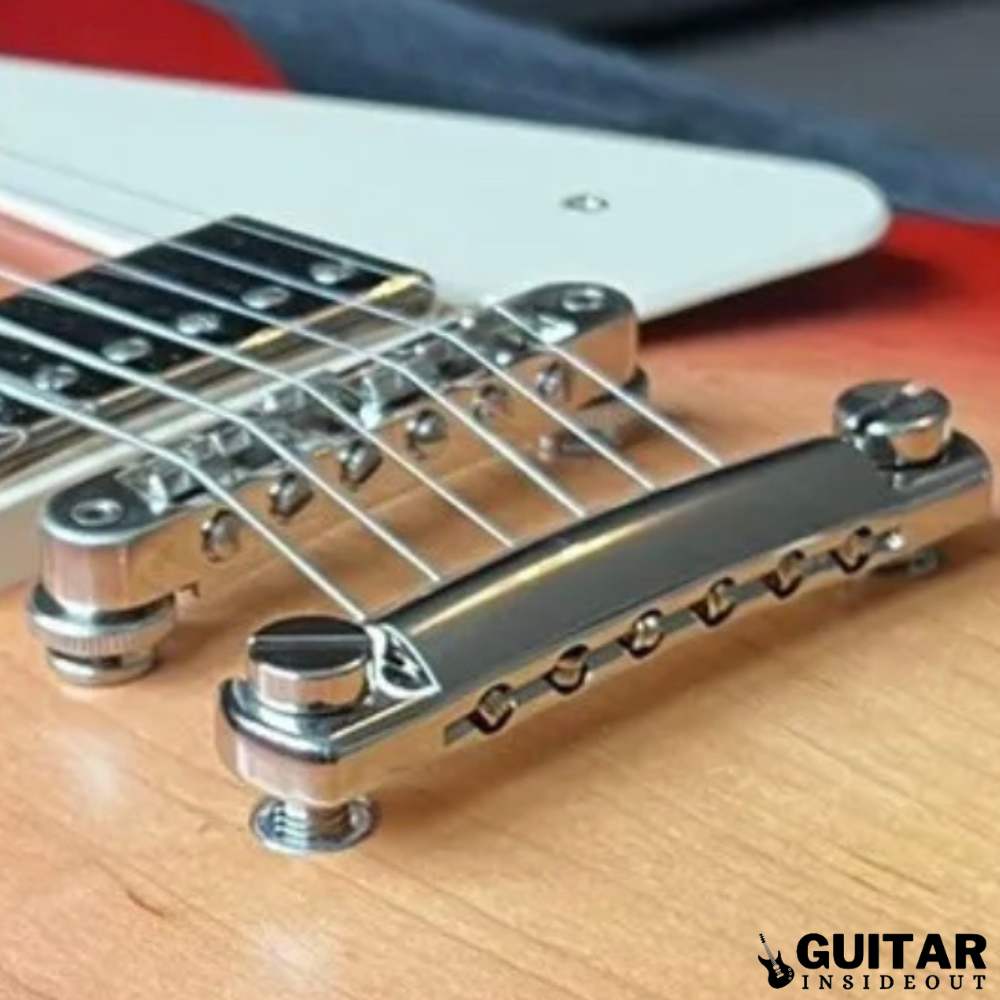
On Tune-O-Matic bridges each string can be individually adjusted for height and intonation at the saddles. This gives you the ability to get 100% perfect intonation for every string, one of the Tune-O-Matics biggest selling points.
As well as that the Tune-O-Matic bridge can be paired with a variety of tailpieces, including the popular stopbar.
Advantages of Tune-O-Matic Bridges
- More adjustability means it is easier to achieve perfect intonation and setup.
- Can be used with a variety of tailpieces including stopbars and Bigsbys.
- Offers good sustain and tone.
Disadvantages of Tune-O-Matic Bridges
- Can be more difficult to set up and maintain than wraparound bridges.
- Some players may find the sharp string angle uncomfortable to play.
Examples of Tune-O-Matic Bridges
Gibson Les Paul’s are the obvious example. From Standard’s to Studio’s and Custom’s so many Gibson’s are known for their Tune-O-Matic bridges. But you’ll find them on Epiphones, PRS’s and many more.

The popularity of Tune-O-Matic bridges and their long term association with Gibson guitars shows they must be doing something right. They are a good mix of versatility and reliability in giving you control over intonation and string height.
Ashtray Bridges
The Ashtray bridge, named because that’s what it looks like, is almost exclusively used on Telecasters. In the past they came with covers but most models nowadays don’t bother with one because it affects the playability (you can’t palm mute with the cover on).
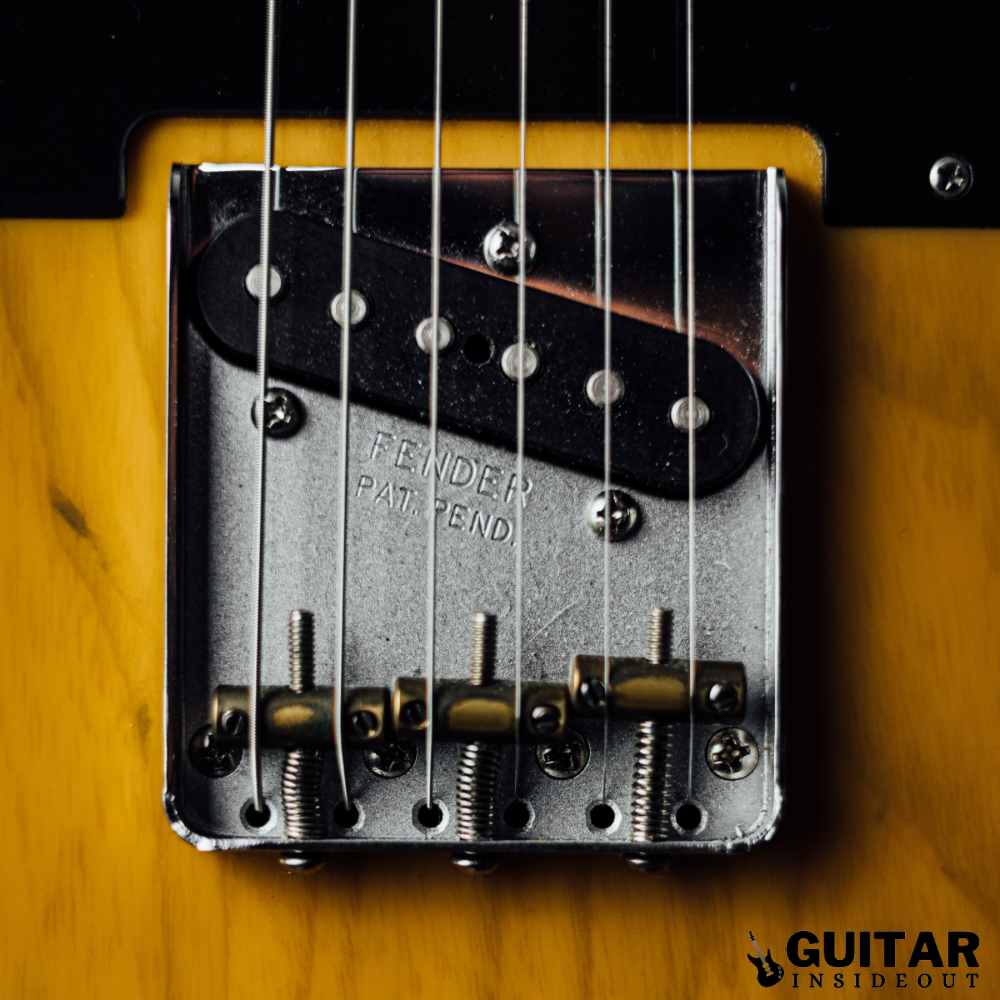
It’s quite a unique bridge and features brass barrel saddles which provide a distinctive bright, ringing tone that is characteristic of vintage Telecaster guitars.
The 3 saddles are typically threaded for height adjustment and intonation and are held in place by small screws that are inserted into the top of the bridge plate. Instead of a saddle for every string instead 2 strings share a saddle together.
Another aspect that sets it apart is its lack of a separate tailpiece. Instead the strings are anchored to the bridge plate itself.
Advantages of Ashtray Bridges
- Aesthetic appeal for players who prefer a vintage look.
- Individual brass barrel saddles can be adjusted for intonation and action.
- Very simple design.
Disadvantages of Ashtray Bridges
- Lack of ability to adjust the intonation of individual strings.
- Brass saddles can wear out over time and may require replacement.
- String tension can cause the bridge plate to dig into the guitar body over time.
Examples of Ashtray Bridges
It’s mainly Telecasters that come with ashtray bridges. Much like Stratocasters are known for the tremolo Telecasters are known for the ashtray.
But Squier and a lot of Telecaster style guitars use the ashtray bridge too – G&L, EastCoast, Chapman and more.

Evertune Bridges
The defining feature of the ‘Evertune’ bridge is that, you guessed it.. it stays in tune forever! Or at least that’s the claim.
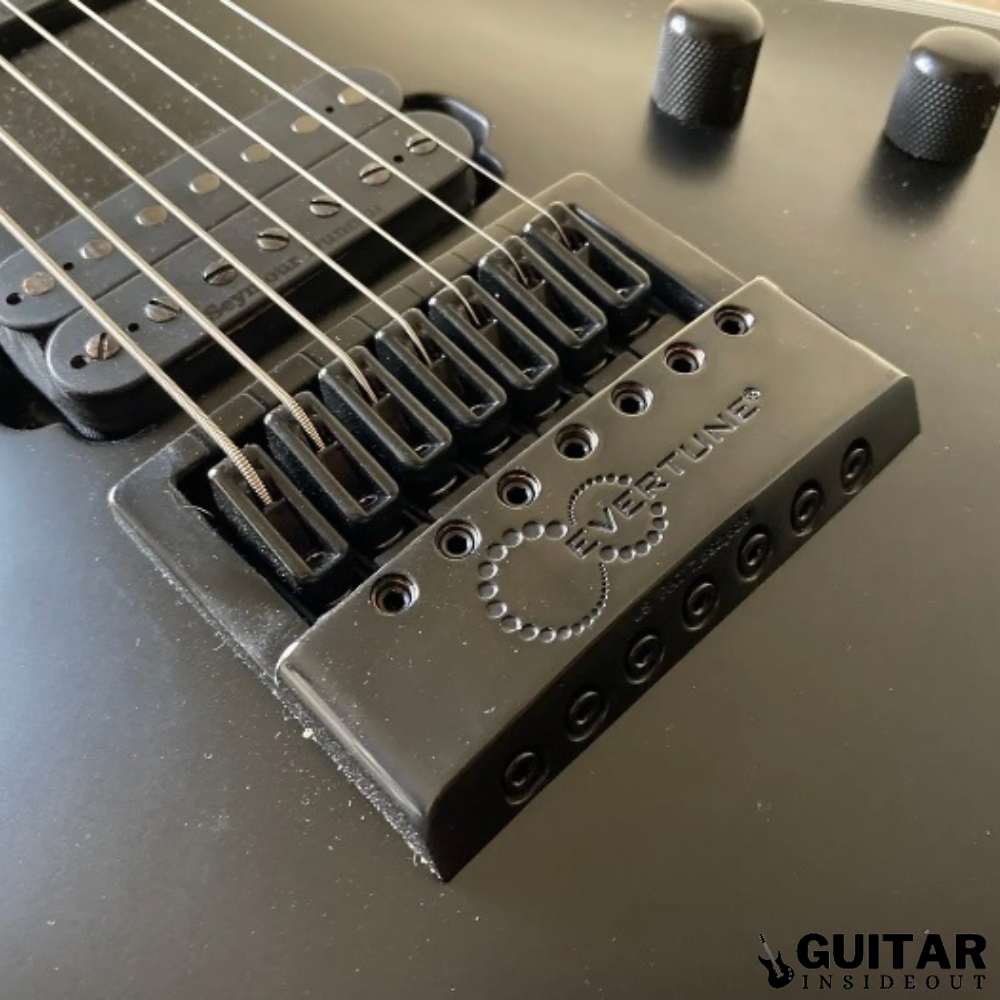
It achieves this by using screws to set the pitch within the saddle. You set that, along with individual screws for action and intonation, and the Evertune should maintain a constant tension on the strings and keep them in tune no matter what.
A neat feature, especially if you use heavier gauges strings that go out of tune a lot. But it doesn’t come cheap and will cost more than most other bridges.
Advantages of Evertune Bridges
- Never loses tuning.
- Simple and easy to use.
- Works well with heavier gauge strings.
Disadvantages of Evertune Bridges
- Cost a lot.
- Might be fixing a problem that’s not a big deal.
Examples of Evertune Bridges
Quite a few ESP guitars come with Evertune bridges at standard along with Ibanez’s, Jackson’s and Dean guitars.

If you really prize the idea of your guitar always being in tune or never having to tune it then the Evertune is worth looking at. But it doesn’t come cheap and for most guitarists it isn’t something they’ll be desperate to get.
Bigsby
Bigsby bridges are probably the least popular type of bridge. They have been around since the 1950’s and are mostly found on hollow-body and semi-hollow body guitars.
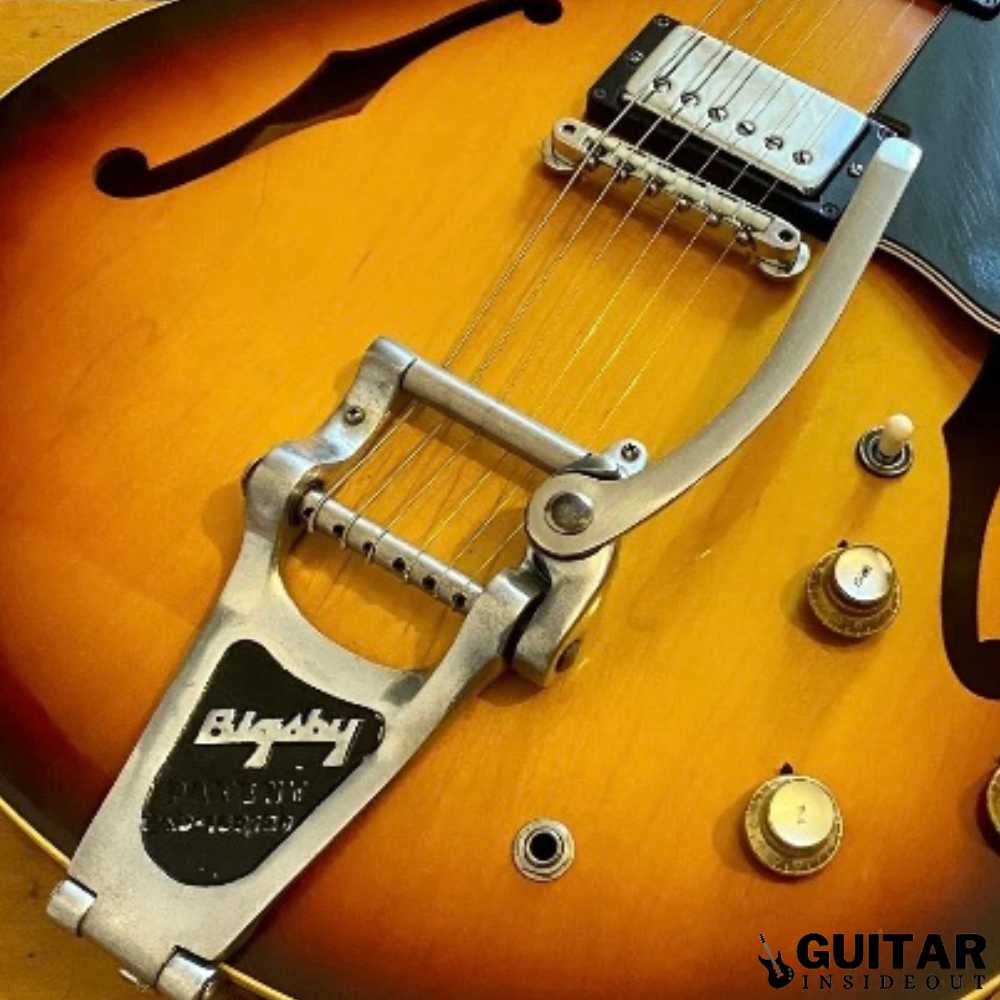
The Bigsby bridge consists of a metal bar or arm that is attached to the guitar’s tailpiece and extends over the strings. When the arm is moved up or down it changes the tension on the strings which causes them to either loosen or tighten. This creates a vibrato effect, similar to the whammy bar/tremolo arm.
A Bigsby differs from other types of vibrato bridges though because it doesn’t rely on springs to create tension. Instead the Bigsby arm is mounted on a pivot point which allows it to move freely.
A regular vibrato bridge has the whammy bar is mounted directly to the bridge of the guitar. This means that the Bigsby arm has a more limited range of motion than the whammy bar.
So due to this limited range the Bigsby arm creates a more subtle and smooth vibrato effect when compared to the whammy bar which produces a wobbly and exaggerated effect.
In terms of playability some guitarists find the Bigsby arm to be easier to use than the whammy bar as it requires less force to create the vibrato effect.
Advantages of Bigsby Bridges
- Offers a unique and vintage-style of vibrato sound.
- Can be used for a variety of playing styles from subtle vibrato to more extreme techniques.
- Simple design means they are relatively easy to set up and maintain.
Disadvantages of Bigsby Bridges
- Less stable than other bridge types which can affect tuning stability.
- A lot more difficult to install than other bridge types, especially if the guitar does not come with a Bigsby.
Examples of Bigsby Bridges
Gretsch guitars are the first that come to my mind when I think of a Bigsby. But while they’re not that common you can find them on special models of a lot of brands.

Fender do a Vintera Telecaster that comes with a Bigsby, for example.

Bigsby bridges are a good choice for players who want a vintage-style vibrato sound. They are relatively simple to set up and maintain but suffer from being less stable than other bridge types.
Types of Acoustic Guitar Bridges
Standard Acoustic Bridge
Acoustic guitar bridges are a lot more straightforward than electrics. They are mostly just a single piece of wood with saddles and bridge pins, no moving parts or springs.
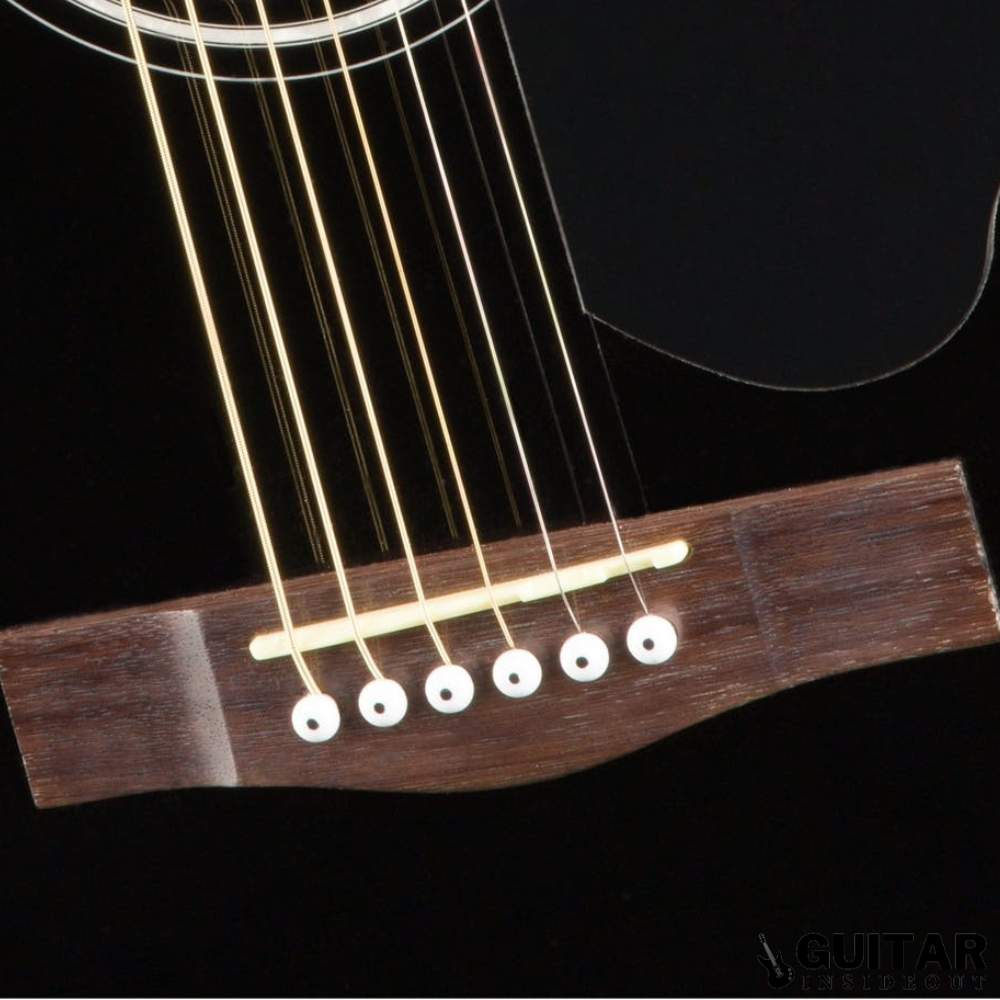
Some acoustic bridges may have a flat or slightly curved shape and are a bit mundane or plain looking. Others may have a more elaborate design with decorative elements. They can also be made from a variety of woods.
The type of wood used to make the bridge has an impact on the guitar’s tone. For example, rosewood is a popular choice for acoustic guitar bridges because it has a warm and balanced tone.
Advantages of Acoustic Bridges
- Bridge pins provide a simple and effective way to hold strings in place.
- Adds to the overall look of the guitar.
Disadvantages of Acoustic Bridges
- Poor placement or installation of the bridge can cause intonation and tuning problems.
- Saddle and bridge pin adjustments can be difficult for inexperienced players.
- Poor quality materials or construction can have a negative impact on the guitar’s tone.
Classical Bridge
Similar to the acoustic bridge, the main component of a classical guitar bridge is the tie block. Usually made of wood, the tie block anchors the strings to the bridge and the strings are tied to the block using a traditional knotting technique.
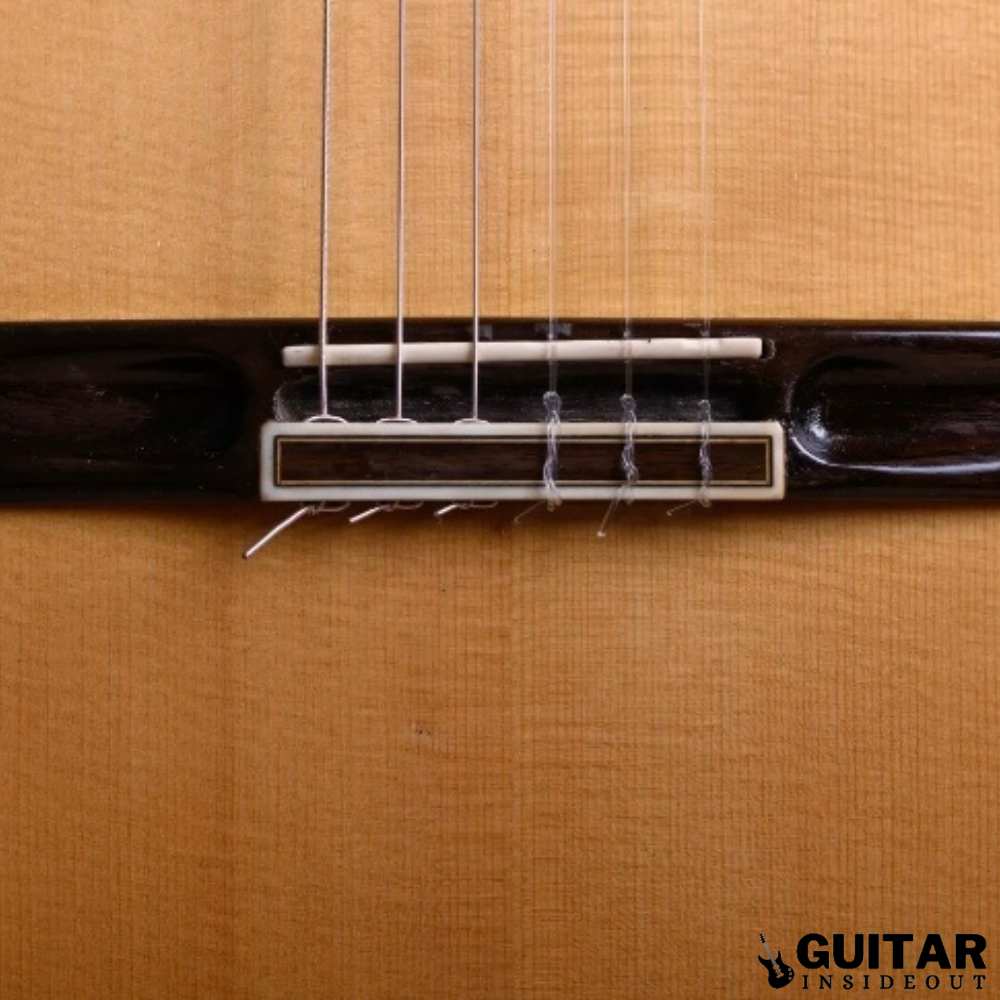
Unlike other types of guitar bridges classical guitar bridges do not have pins or adjustable saddles. Instead the saddle is carved directly into the bridge and is typically made of bone.
The design of a classical guitar bridge is simple and unadorned with a straight or slightly curved shape. Some bridges may feature decorations or inlays but they are far less common than on other types of bridges.
Pinless Bridge
Pinless bridges, unlike regular acoustic bridges, don’t use pins to hold the strings in place. What happens instead is the bridge features a small groove or notch where the ball end of the string goes. After that there is a wedge that locks the string into place.
This allows you to change strings quickly and easily as they can be removed and reinstalled without messing about with pins. Plus there’s no risk of losing or damaging the pins, something that happens a fair amount with regular acoustic bridges.
It’s also claimed that the lack of pins can have a positive impact on the guitar’s tone. When you don’t have any pins there aren’t as many points of contact between the string and the bridge. This results in more of the vibration of the strings being transferred to the body which gives a better and more resonant sound.
But it’s not all good. Pinless bridges can make adjusting the intonation of the strings more difficult.
Without any adjustable saddles like on other types of guitar bridges you lose the ability to really fine tune things like intonation. They also put extra pressure on the body of the guitar where the bridge is located.
Advantages of Pinless Bridges
- Easy and quick to change strings.
- No losing pins and having to replace them.
- Potentially better tone.
Disadvantages of Pinless Bridges
- Difficulty adjusting of intonation .
- Extra pressure on guitar body.
Fixed Bridge vs Floating Bridge
Floating/vibrato bridges offer you more options: you get the whammy bar and ability to bend the pitch of the strings and create different sounds and techniques.
But a floating bridge, as the name suggests, “floats” above the guitar body. This means they aren’t in contact with the body of the guitar and this reduces the amount of sound that is transferred through it.
That in turn leads to less sustain. So you’re trading in sustain and tone for the tremolo system.
The fixed bridge doesn’t suffer from this issue as it is bolted directly to the body. So the transfer of sound isn’t impacted which means fixed bridges give greater sustain and resonance.
Floating bridges with tremolo also have the problem of going out of tune often. If you use the whammy bar a lot then the guitar will go out of tune frequently.
If you don’t use it too much then it may not lose tuning that often, especially if you get a good Floyd Rose. A Strat style bridge however goes out of tune with even a little use of the whammy bar.
It really comes down to what you want though. If you don’t really care about the tremolo then stick with a fixed bridge. It’s far less hassle.
But if you really want or need one then you’re going to have to accept the limitations and problems that come with it. Don’t get me wrong, lots of guitarists use guitars with tremolo systems so it’s not like they’re unstable.
But you will face the issues with tuning, difficulty setting them up, its a pain restring or replacing a broken string and they do reside the amount of sustain.
Why the Bridge Matters
Without a bridge a guitar wouldn’t function. It’s absolutely essential.
The simplest way to look at it is like this – if you removed the bridge from a guitar the strings wouldn’t be attached. They’d just hang and flop all over the place.
So at a really basic level that’s how important it is. But obviously the bridge does more than that.
So let’s take a look at exactly what a guitar bridge does:
Aligns the Strings
Along with the nut the bridge keeps the strings and straight.
Sets the Action
If you want to adjust the height of your strings then that’s almost exclusively done from the bridge.
Adjusts Intonation
The saddles at the bridge allow you to adjust the intonation and individually fine tune the strings.
Creates Tremolo
Floating bridges are designed specifically so you can use the whammy bar and alter the pitch (creating a tremolo affect).
Factors to Consider When Choosing a Guitar Bridge
When choosing a guitar bridge, there are a few factors to consider:
- Ease of use and maintenance: this for me is the main consideration. Unless you have specific needs then choosing a bridge that is easy to use and won’t cause you any major problems is the way to go. You want to be able to tune, restring and setup your guitar/bridge as simply as possible.
- Playing style: the style of music you play will affect the type of bridge you want or need. For example tremolo bridges are a great choice for players who use a lot of vibrato or do dive bombs. But a fixed bridges is going to be better for players who are concerned about always staying in tune. So make sure you think about what music you play and what you really want.
- Sound: Similar to your playing style different bridge types can affect the sound. Bigsby bridges, as an example, are known for giving a subtle vibrato effect whereas tremolo’s are far more ‘in-your-face’. So it’s important to know what each bridge sounds like and if it matches what you’re looking for.
- Type of Guitar: The type of guitar you have or want will also be key to the bridge you get. Some guitars, like Gibson-style models, are designed to work best with Tune-o-Matic bridges. Others, like Fender-style guitars, are designed for tremolo bridges. So the guitar you currently have will have to accommodate the bridge you want.
- Budget: Lastly budget is always a consideration. Some types of bridges, like Floyd Rose’s, can be expensive. So you’ll want to make sure you’re getting the most value for your money.
So consider the factors above, make sure you do research and try out different types of bridges to find the one that works best for you.
Bridge Materials
The material a guitar guitar bridge is made from is also something to be aware of. Different materials can make big differences to the sustain and tone of a guitar.
There’s also how they feel. Some materials will be more comfortable to play and rest your hand against.
- Steel: Steel bridges are known for their bright and clear sound (think the twang of a Telecaster) and have strong sustain.
- Brass: a brass bridge offers a warmer and more mellow tone than steel bridges. It’s used less often now but was the choice bridge material in the 70’s and 80’s.
- Titanium: has a bright, articulate sound with excellent sustain.
- Aluminum: aluminum is known for being lightweight and provides a balanced tone with good sustain.
- Wood: Wooden bridges can provide a warm and natural sound with a softer attack.
Hybrid Bridges
Away from the traditional bridge types you can now get hybrid bridges that combine elements of the most popular features from regular bridges. So you could have a combination of the built in tremolo system or a Tune-O-Matic bridge with a Bigsby vibrato arm, as an example.
The idea behind hybrid bridges is that you get the best of both worlds. A combination of the stability and sustain of a fixed bridge with the pitch bending of a tremolo or vibrato system.
The downsides? Because there’s always a catch. Sadly they can be more complex to set up and maintain than traditional bridges.
A good example of a hybrid bridge is the Gibson SG Standard which has a tune-o-matic bridge and a Maestro Vibrola tremolo system.
Installing and Maintaining Bridges
Each type of bridge has different requirements for both installing and maintaining it. If you’re a beginner then it can be daunting to try and install your own bridge or do a proper setup of it.
Thankfully with a little bit of know-how it’s very possible to do it yourself. But how much work is involved might be a factor in deciding if a certain type of bridge is the right one for you.
Here’s a few tips for installing and maintaining different types of bridges:
- Fixed bridges: a fixed bridge is relatively easy to install and maintain. You just have to make sure the bridge is properly aligned with the strings and the intonation is set correctly. Apart from that check the bridge and saddle periodically for signs of wear or corrosion.
- Tremolo bridges: frankly they’re a hassle. Far more complex to set up and maintain than fixed bridges. You have to ensure the bridge is properly balanced and the string tension is set correctly, which isn’t easy. On going maintenance means the tremolo arm and springs need proper tension and the bridge saddles should be lubricated on a semi-regular basis.
- Tune-O-Matic bridges: even though my main guitar is a Telecaster I do like Tune-O-Matic bridges a lot. They feel just as simple to use as a fixed bridge to me. And in terms of installation and maintenance they’re basically the same. Keep them free of corrosion and they should last you a long time without any problems.
Customizing Bridges
Modifying guitars is really common. And the bridge is one area that often gets changed or upgraded.
Some popular modifications include:
- Upgrading the bridge material: Swapping out a stock bridge for one made from higher quality material can improve the guitar’s sustain and tone.
- Adding a vibrato system: a lot of guitarists like to experiment with installing a tremolo just to see how it feels or sounds.
- Adjusting the string spacing: if you have smaller hands or play a certain way then changing the space between the strings can make things more comfortable. Different bridges will have wider or narrower spacing so it can be interesting to switch yours out and try another one.